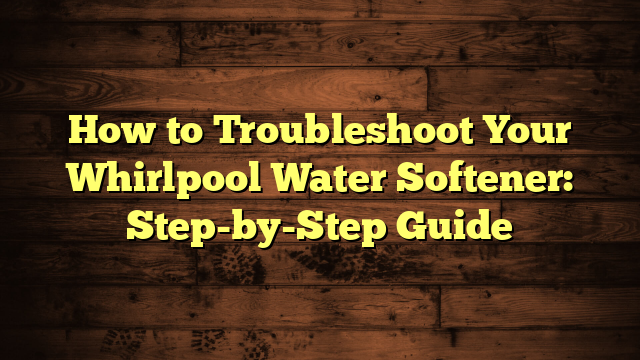How to Troubleshoot Your Whirlpool Water Softener: Step-by-Step Guide
Did you know that nearly 80% of homes in the U.S. have hard water, which can lead to various plumbing issues? If you're experiencing problems with your Whirlpool water softener, you're not alone, and it's essential to address these concerns promptly. Start by understanding common issues like salt bridging and error codes, as these can greatly impact your system's performance. By following a step-by-step approach, you can effectively troubleshoot and maintain your softener, ensuring it operates efficiently. What steps should you take first to get your water softener back on track?
Key Takeaways
- Check settings to ensure the water softener is configured correctly for optimal performance and efficiency.
- Inspect salt levels in the brine tank regularly; refill as needed to maintain effective softening.
- Monitor regeneration cycles to confirm they are functioning properly and effectively treating the water.
- Test water quality post-treatment to assess hardness levels and identify any persistent issues.
- Document any error codes and corresponding troubleshooting steps for future reference or professional assistance.
Common Problems With Water Softeners
Over time, you might encounter several common problems with your water softener. One of the most noticeable issues is water hardness. If your water feels gritty or leaves mineral deposits on dishes, it's a sign your softener isn't working properly. This can happen for several reasons, including low salt levels or a malfunctioning resin bed.
To keep your water softener operating at peak performance, regular maintenance is key. Check the salt levels frequently and refill them as needed. If you notice a decrease in effectiveness, consider performing a regeneration cycle to refresh the resin beads.
Another useful maintenance tip is to inspect the unit for leaks or clogs, as these can also affect its efficiency.
If your water softener is still underperforming after following these tips, it might be time to consult the manual or contact a professional. Being proactive about these common issues can save you time and money in the long run.
Identifying Salt Bridging Issues
Many water softener owners unknowingly deal with salt bridging, a common issue that can greatly hinder performance. Salt bridge formation occurs when a hard crust forms on top of the salt in your water softener's brine tank. This crust prevents the salt from dissolving properly, leading to inadequate softening.
To help you identify signs of bridging, here's a quick reference table:
| Signs of Bridging | Potential Causes | Suggested Actions |
|---|---|---|
| Hard or spotty water | Insufficient salt in tank | Check salt levels regularly |
| Salt remaining in tank | Improper salt type or quality | Use high-quality salt |
| System regeneration issues | Salt bridge formation | Inspect for crusty salt buildup |
| Unusual noises during operation | Salt clumps in tank | Break up clumps with a stick |
If you notice any of these signs, it's vital to address the issue immediately. Start by inspecting your brine tank for any hard crust or solid salt masses. If you identify a salt bridge, you can break it up gently to restore your water softener's efficiency. Regular maintenance can help prevent these issues from arising in the first place.
Checking Water Pressure Levels
Before troubleshooting any further, it's essential to check the water pressure levels in your home. Low water pressure can greatly impact your Whirlpool water softener's performance.
To start, locate a pressure gauge, which is often found at your main water supply line or near the water softener itself.
Once you have the pressure gauge, attach it to a faucet or connection point. Turn on the water and observe the gauge; it should read between 40 to 60 psi for ideal softener operation.
If the reading is below this range, low water pressure might be causing issues such as insufficient water flow through the system.
In some cases, you might notice fluctuating pressure levels, which can also disrupt the softener's efficiency.
If your water pressure is low, check for potential causes like leaks in your plumbing, clogged pipes, or issues with your municipal water supply.
Taking the time to verify adequate water pressure levels will help you identify whether pressure issues are affecting your water softener's performance, paving the way for more effective troubleshooting steps.
Understanding Error Codes
When your Whirlpool water softener shows an error code, it's crucial to understand what it means.
These codes can point to specific issues, helping you troubleshoot effectively and get your system back on track.
Let's break down some common error codes and the steps you can take to resolve them.
Common Error Codes
Understanding common error codes on your Whirlpool water softener is essential for effective troubleshooting. These codes alert you to specific issues and help you determine the right course of action. Familiarizing yourself with the error code meanings can save you time and frustration.
For instance, the "Error Code 1" typically indicates a salt level issue, while "Error Code 2" suggests a problem with the system's ability to regenerate. When you encounter these codes, don't panic; instead, refer to your user manual for troubleshooting tips specific to your model.
Additionally, consider keeping a log of these error codes and their meanings, so you can track recurring problems. This can help you notice patterns and decide if it's time for a repair or service.
Lastly, remember that regular maintenance can prevent many of these errors from occurring in the first place. By staying proactive, you'll guarantee your water softener runs smoothly, providing you with soft water without interruption.
Understanding these common error codes empowers you to take charge of your water softener's performance, making troubleshooting a breeze.
Troubleshooting Steps Explained
Troubleshooting your Whirlpool water softener involves breaking down the error codes to pinpoint the issue. By understanding these codes, you can identify the underlying problem and take necessary actions.
Start with the troubleshooting basics: check your user manual, as it provides specific error code meanings and solutions. For instance, a common error like "E1" typically signifies a salt issue, while "E2" might indicate a flow problem.
Next, verify your softener maintenance routine is up to date. This includes checking the salt level, cleaning the brine tank, and inspecting the resin beads.
If you encounter an error code, don't panic—take a deep breath and address it systematically. Resetting the unit can sometimes resolve minor glitches, but if the code persists, follow the manual's guidance on troubleshooting steps.
Document any error codes and your actions; this record will be useful if you need to contact customer support.
Cleaning and Maintaining Your System
To keep your Whirlpool water softener running smoothly, regular maintenance is key.
You should check the salt level frequently, clean the resin bed, and follow proper valve maintenance procedures.
Taking these steps won't only extend the life of your system but also guarantee peak performance.
Regular Salt Level Checks
Keeping an eye on the salt level in your Whirlpool water softener is crucial for its ideal performance. If the salt level gets too low, your system can't effectively soften water, leading to scale buildup and other issues. Typically, you should check the salt level at least once a month as part of your maintenance schedule.
There are various salt types available, including solar salt, rock salt, and evaporated salt. Each type has its pros and cons, but evaporated salt is often recommended for its purity and effectiveness.
When checking the salt level, you should aim to keep it at least half full. If the salt level dips below this mark, add more salt to guarantee optimal performance.
Additionally, if you notice any salt bridging—where a hard crust forms on the surface of the salt—this can prevent the brine from dissolving properly. In such cases, it's important to break up the bridge or remove it entirely.
Regular salt checks and proper maintenance will help keep your Whirlpool water softener running smoothly, guaranteeing you enjoy clean, soft water throughout your home.
Resin Bed Cleaning
Your Whirlpool water softener's resin bed plays an essential role in the water softening process, so regular cleaning is vital for maintaining its efficiency. Over time, the resin bed can accumulate dirt, debris, and mineral buildup, which can hinder its performance. To keep your system running smoothly, follow a cleaning frequency that suits your water hardness and usage.
Here's a handy guide for your resin bed cleaning:
| Cleaning Task | Frequency | Notes |
|---|---|---|
| Initial Cleaning | Every 6 months | Use a resin cleaner |
| Light Cleaning | Annually | Check for efficiency loss |
| Heavy Cleaning | Every 2 years | Consider professional help |
| Visual Inspection | Monthly | Look for clogs or discoloration |
Valve Maintenance Procedures
Maintaining the valve of your Whirlpool water softener is essential for guaranteeing ideal performance. Regular valve inspection techniques help you identify early signs of wear or malfunction.
Start by checking for leaks or unusual noises during regeneration cycles. If you notice any issues, it's imperative to address them promptly to prevent further damage.
Cleaning the valve is equally important. Use a mixture of vinegar and water to remove any mineral buildup that might interfere with operation.
After cleaning, make sure the valve's moving parts are well-lubricated to assure smooth functioning.
If your inspection reveals significant wear or damage, you should follow valve replacement guidelines. First, disconnect the power and water supply to the softener.
Remove the old valve carefully, making sure to note the configuration for reinstallation. Install the new valve according to the manufacturer's instructions, confirming all connections are secure.
Finally, test the system after installation to verify everything is working properly. Regular maintenance not only extends the life of your water softener but also guarantees you get the best performance from your system.
Don't overlook this critical aspect of your water softener care.
When to Call a Professional
If your Whirlpool water softener continues to show issues despite your best troubleshooting efforts, it might be time to call a professional. Knowing when to consult an expert is critical for preserving the longevity and efficiency of your water softener.
Watch for signs to hire a professional, such as persistent error codes that won't clear, unusual noises during operation, or continuous water hardness despite regeneration cycles. If you've replaced the salt, cleaned the brine tank, and verified the settings, yet problems persist, an expert can diagnose underlying issues that may not be apparent.
Additionally, if you notice leaks or water pooling around the unit, don't hesitate to seek help. These issues can lead to further damage if left unaddressed.
Finally, if you're uncomfortable with DIY repairs or lack the tools needed for extensive maintenance, it's wise to reach out to a qualified technician. They've the training and experience to resolve complex issues safely and efficiently.
Frequently Asked Questions
How Often Should I Regenerate My Water Softener?
You should set your water softener's regeneration frequency based on your water usage and hardness levels. Adjusting to ideal settings guarantees efficient operation, so monitor your system and tweak as necessary for best results.
Can I Use Regular Table Salt in My Water Softener?
You shouldn't use regular table salt in your water softener. It can harm the system. Instead, consider table salt alternatives designed for water softeners. Proper maintenance guarantees your unit runs efficiently and lasts longer.
What Is the Lifespan of a Water Softener?
Think of your water softener as a trusty old friend. With proper water softener maintenance, it can last 10-15 years, but neglect may speed up water softener replacement. Keep it healthy for lasting companionship!
How Do I Know if My Water Softener Is Working?
To know if your water softener's working, check your water quality. Look for performance indicators like soap not lathering well or spots on dishes. If you notice these, it may need maintenance or repair.
What Size Water Softener Do I Need for My Home?
Choosing the right water softener's like finding the perfect pair of shoes; it needs to fit your household size and tackle your water hardness. Generally, larger families require bigger systems to keep things flowing smoothly.
Conclusion
In the end, troubleshooting your Whirlpool water softener might feel like a game of detective—who knew your appliance could be so elusive? By checking settings, salt levels, and regeneration cycles, you might just uncover the mystery behind hard water. Remember, if you find yourself staring at error codes that make no sense, it's okay to call in the pros. After all, even the best detectives sometimes need a sidekick. Happy softening!







